Reflective Report on Business Strategy Game (BSG) - F TEZRON
VerifiedAdded on 2024/05/30
|14
|4019
|230
AI Summary
This report provides a comprehensive analysis of the Business Strategy Game (BSG) using F TEZRON as a case study. It delves into the company's vision, mission, and corporate objectives, followed by a thorough situational analysis using PESTLE and Porter's Five Forces frameworks. The report further examines the internal environment through a balance scorecard, competitive advantage assessment, and SWOT analysis. It then explores the implementation of the marketing strategy, including the 7 Ps, design, style, and quality issues, and the role of celebrity endorsement and brand management. The report concludes with a performance analysis, focusing on financing operations and corporate social responsibility, and provides recommendations for future strategy, milestones, and leadership.
Contribute Materials
Your contribution can guide someone’s learning journey. Share your
documents today.
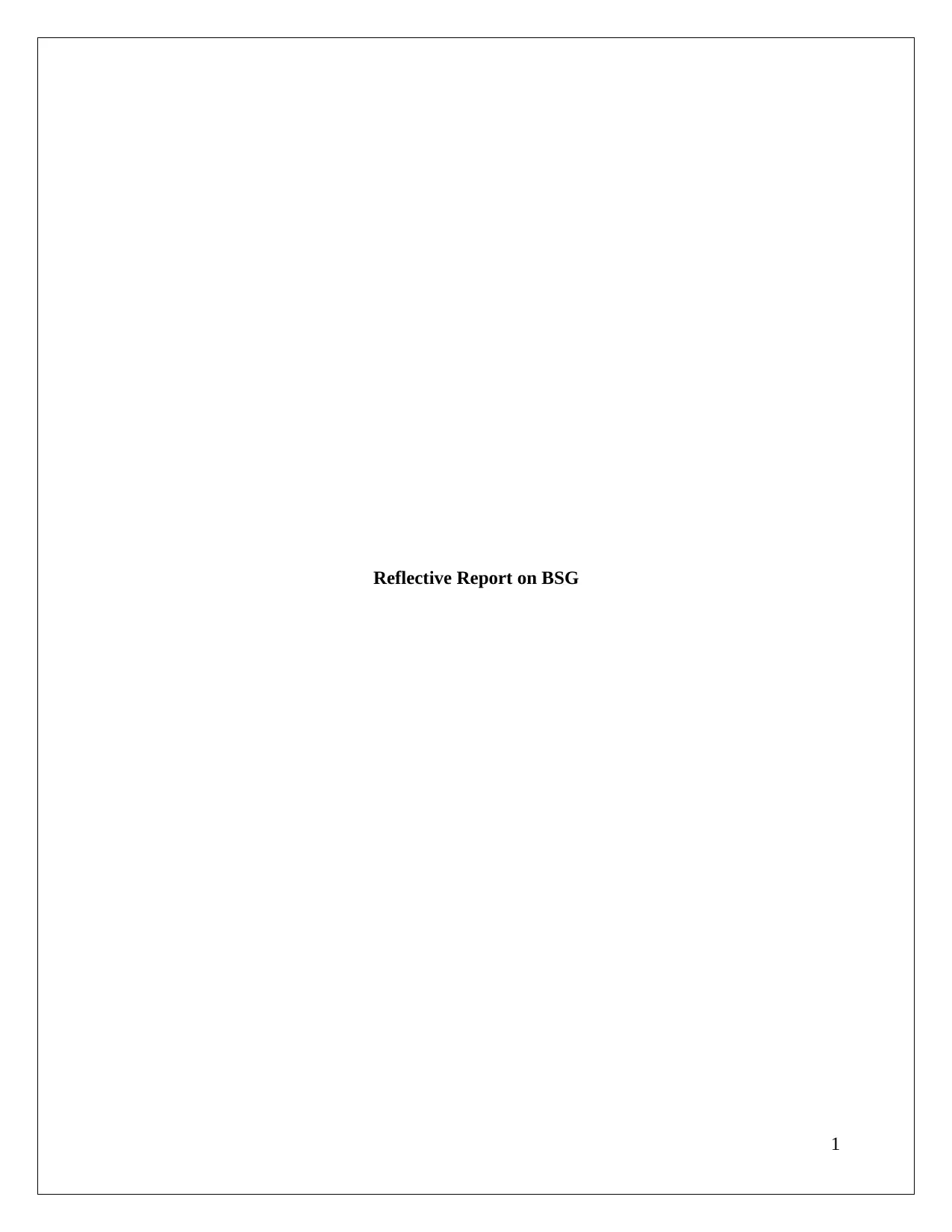
Reflective Report on BSG
1
1
Secure Best Marks with AI Grader
Need help grading? Try our AI Grader for instant feedback on your assignments.
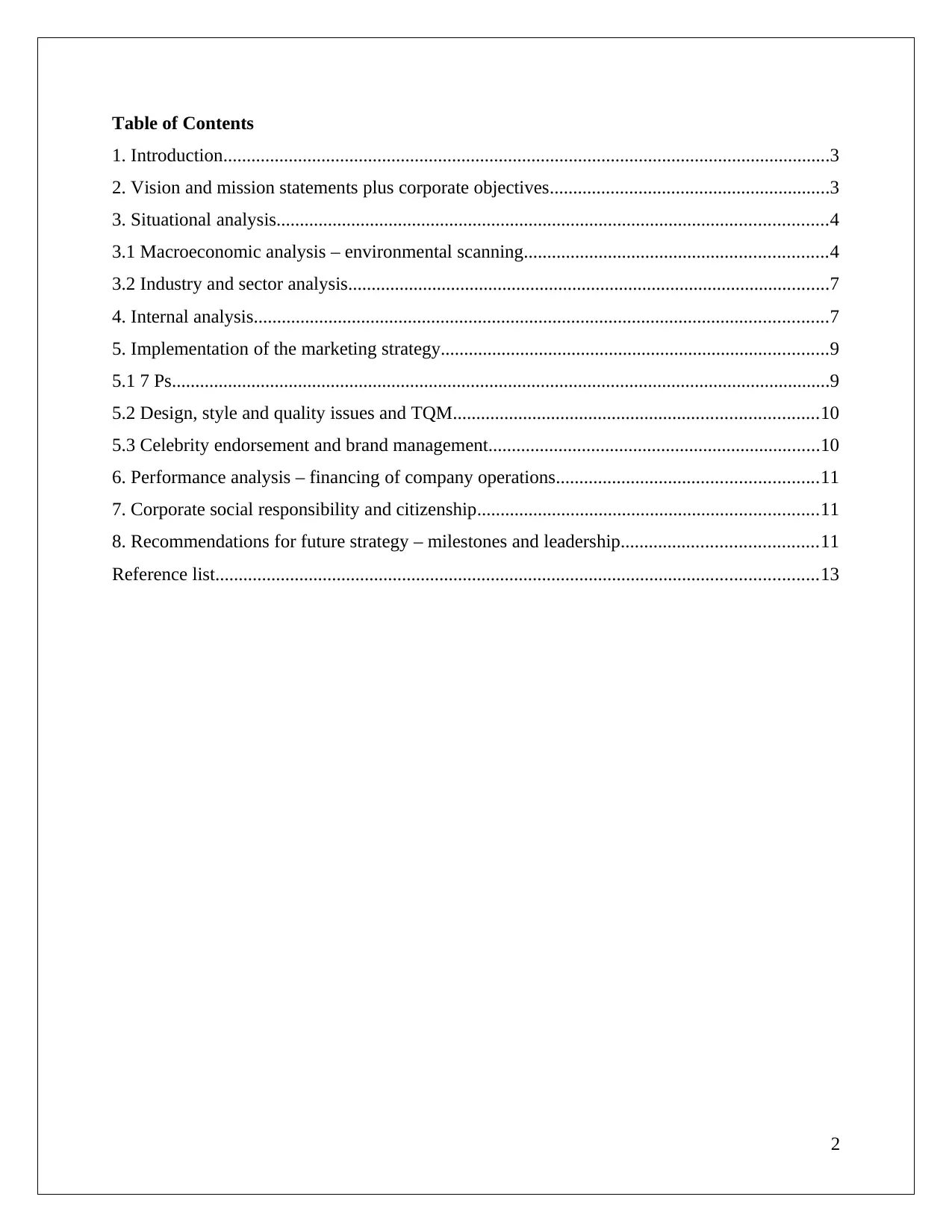
Table of Contents
1. Introduction..................................................................................................................................3
2. Vision and mission statements plus corporate objectives............................................................3
3. Situational analysis......................................................................................................................4
3.1 Macroeconomic analysis – environmental scanning.................................................................4
3.2 Industry and sector analysis.......................................................................................................7
4. Internal analysis...........................................................................................................................7
5. Implementation of the marketing strategy...................................................................................9
5.1 7 Ps.............................................................................................................................................9
5.2 Design, style and quality issues and TQM..............................................................................10
5.3 Celebrity endorsement and brand management.......................................................................10
6. Performance analysis – financing of company operations........................................................11
7. Corporate social responsibility and citizenship.........................................................................11
8. Recommendations for future strategy – milestones and leadership..........................................11
Reference list.................................................................................................................................13
2
1. Introduction..................................................................................................................................3
2. Vision and mission statements plus corporate objectives............................................................3
3. Situational analysis......................................................................................................................4
3.1 Macroeconomic analysis – environmental scanning.................................................................4
3.2 Industry and sector analysis.......................................................................................................7
4. Internal analysis...........................................................................................................................7
5. Implementation of the marketing strategy...................................................................................9
5.1 7 Ps.............................................................................................................................................9
5.2 Design, style and quality issues and TQM..............................................................................10
5.3 Celebrity endorsement and brand management.......................................................................10
6. Performance analysis – financing of company operations........................................................11
7. Corporate social responsibility and citizenship.........................................................................11
8. Recommendations for future strategy – milestones and leadership..........................................11
Reference list.................................................................................................................................13
2
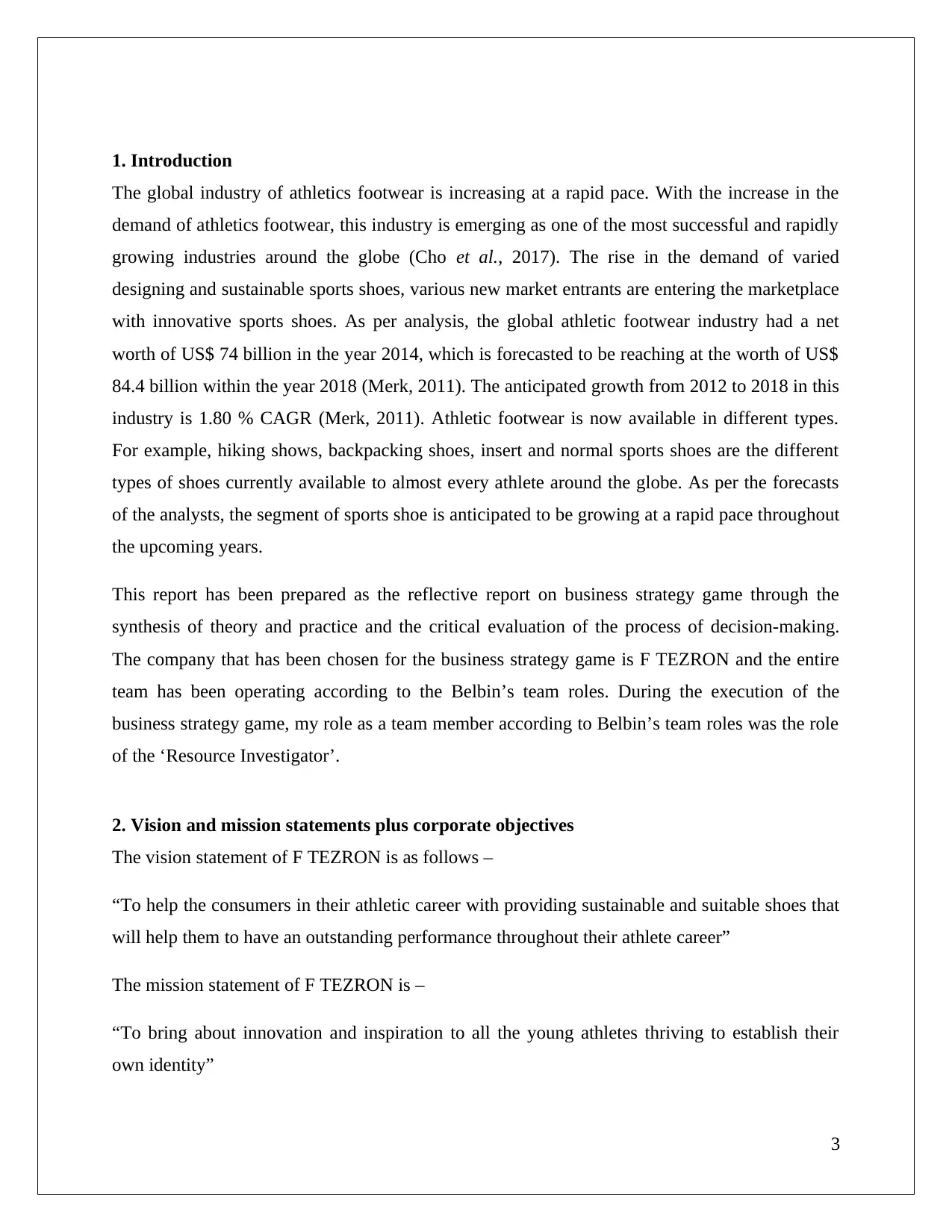
1. Introduction
The global industry of athletics footwear is increasing at a rapid pace. With the increase in the
demand of athletics footwear, this industry is emerging as one of the most successful and rapidly
growing industries around the globe (Cho et al., 2017). The rise in the demand of varied
designing and sustainable sports shoes, various new market entrants are entering the marketplace
with innovative sports shoes. As per analysis, the global athletic footwear industry had a net
worth of US$ 74 billion in the year 2014, which is forecasted to be reaching at the worth of US$
84.4 billion within the year 2018 (Merk, 2011). The anticipated growth from 2012 to 2018 in this
industry is 1.80 % CAGR (Merk, 2011). Athletic footwear is now available in different types.
For example, hiking shows, backpacking shoes, insert and normal sports shoes are the different
types of shoes currently available to almost every athlete around the globe. As per the forecasts
of the analysts, the segment of sports shoe is anticipated to be growing at a rapid pace throughout
the upcoming years.
This report has been prepared as the reflective report on business strategy game through the
synthesis of theory and practice and the critical evaluation of the process of decision-making.
The company that has been chosen for the business strategy game is F TEZRON and the entire
team has been operating according to the Belbin’s team roles. During the execution of the
business strategy game, my role as a team member according to Belbin’s team roles was the role
of the ‘Resource Investigator’.
2. Vision and mission statements plus corporate objectives
The vision statement of F TEZRON is as follows –
“To help the consumers in their athletic career with providing sustainable and suitable shoes that
will help them to have an outstanding performance throughout their athlete career”
The mission statement of F TEZRON is –
“To bring about innovation and inspiration to all the young athletes thriving to establish their
own identity”
3
The global industry of athletics footwear is increasing at a rapid pace. With the increase in the
demand of athletics footwear, this industry is emerging as one of the most successful and rapidly
growing industries around the globe (Cho et al., 2017). The rise in the demand of varied
designing and sustainable sports shoes, various new market entrants are entering the marketplace
with innovative sports shoes. As per analysis, the global athletic footwear industry had a net
worth of US$ 74 billion in the year 2014, which is forecasted to be reaching at the worth of US$
84.4 billion within the year 2018 (Merk, 2011). The anticipated growth from 2012 to 2018 in this
industry is 1.80 % CAGR (Merk, 2011). Athletic footwear is now available in different types.
For example, hiking shows, backpacking shoes, insert and normal sports shoes are the different
types of shoes currently available to almost every athlete around the globe. As per the forecasts
of the analysts, the segment of sports shoe is anticipated to be growing at a rapid pace throughout
the upcoming years.
This report has been prepared as the reflective report on business strategy game through the
synthesis of theory and practice and the critical evaluation of the process of decision-making.
The company that has been chosen for the business strategy game is F TEZRON and the entire
team has been operating according to the Belbin’s team roles. During the execution of the
business strategy game, my role as a team member according to Belbin’s team roles was the role
of the ‘Resource Investigator’.
2. Vision and mission statements plus corporate objectives
The vision statement of F TEZRON is as follows –
“To help the consumers in their athletic career with providing sustainable and suitable shoes that
will help them to have an outstanding performance throughout their athlete career”
The mission statement of F TEZRON is –
“To bring about innovation and inspiration to all the young athletes thriving to establish their
own identity”
3
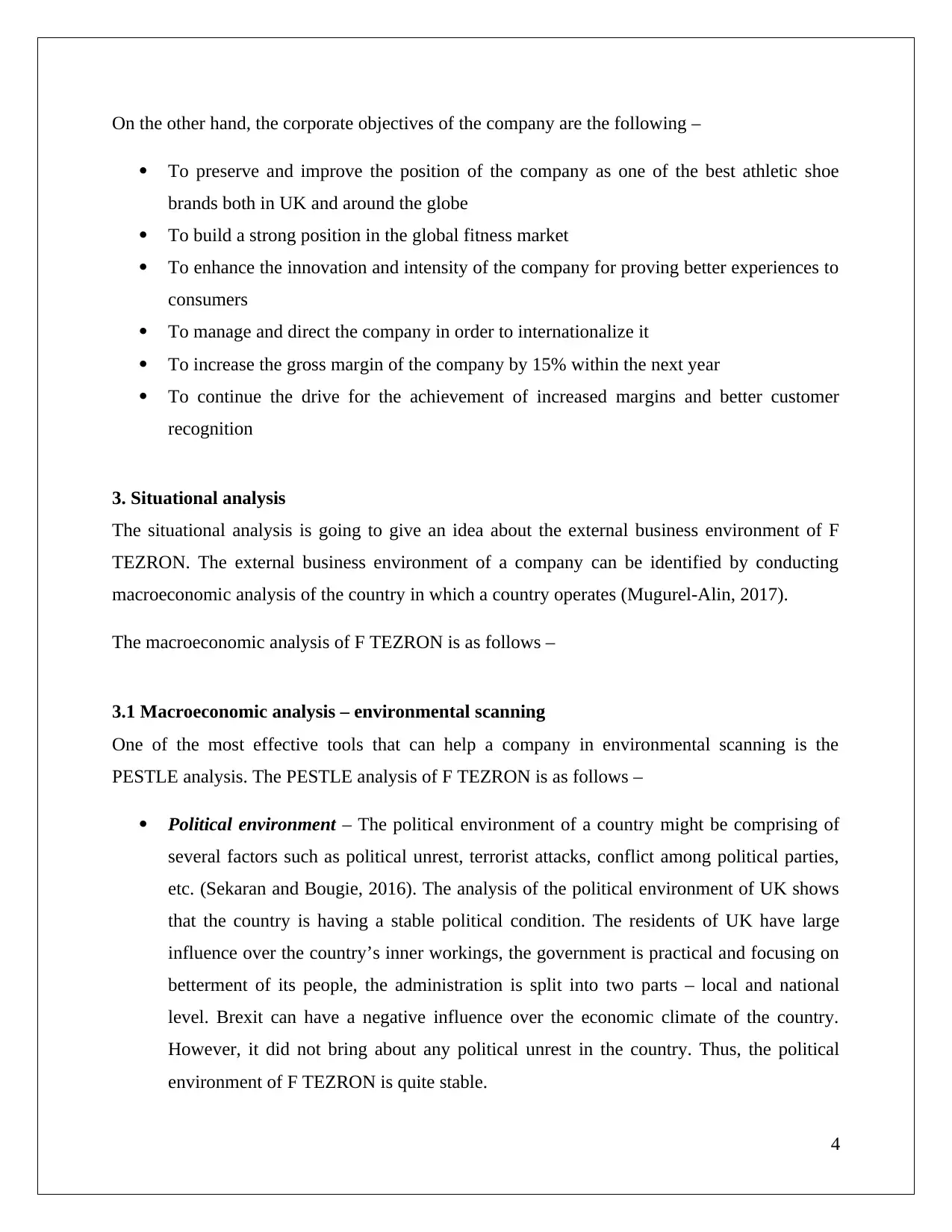
On the other hand, the corporate objectives of the company are the following –
To preserve and improve the position of the company as one of the best athletic shoe
brands both in UK and around the globe
To build a strong position in the global fitness market
To enhance the innovation and intensity of the company for proving better experiences to
consumers
To manage and direct the company in order to internationalize it
To increase the gross margin of the company by 15% within the next year
To continue the drive for the achievement of increased margins and better customer
recognition
3. Situational analysis
The situational analysis is going to give an idea about the external business environment of F
TEZRON. The external business environment of a company can be identified by conducting
macroeconomic analysis of the country in which a country operates (Mugurel-Alin, 2017).
The macroeconomic analysis of F TEZRON is as follows –
3.1 Macroeconomic analysis – environmental scanning
One of the most effective tools that can help a company in environmental scanning is the
PESTLE analysis. The PESTLE analysis of F TEZRON is as follows –
Political environment – The political environment of a country might be comprising of
several factors such as political unrest, terrorist attacks, conflict among political parties,
etc. (Sekaran and Bougie, 2016). The analysis of the political environment of UK shows
that the country is having a stable political condition. The residents of UK have large
influence over the country’s inner workings, the government is practical and focusing on
betterment of its people, the administration is split into two parts – local and national
level. Brexit can have a negative influence over the economic climate of the country.
However, it did not bring about any political unrest in the country. Thus, the political
environment of F TEZRON is quite stable.
4
To preserve and improve the position of the company as one of the best athletic shoe
brands both in UK and around the globe
To build a strong position in the global fitness market
To enhance the innovation and intensity of the company for proving better experiences to
consumers
To manage and direct the company in order to internationalize it
To increase the gross margin of the company by 15% within the next year
To continue the drive for the achievement of increased margins and better customer
recognition
3. Situational analysis
The situational analysis is going to give an idea about the external business environment of F
TEZRON. The external business environment of a company can be identified by conducting
macroeconomic analysis of the country in which a country operates (Mugurel-Alin, 2017).
The macroeconomic analysis of F TEZRON is as follows –
3.1 Macroeconomic analysis – environmental scanning
One of the most effective tools that can help a company in environmental scanning is the
PESTLE analysis. The PESTLE analysis of F TEZRON is as follows –
Political environment – The political environment of a country might be comprising of
several factors such as political unrest, terrorist attacks, conflict among political parties,
etc. (Sekaran and Bougie, 2016). The analysis of the political environment of UK shows
that the country is having a stable political condition. The residents of UK have large
influence over the country’s inner workings, the government is practical and focusing on
betterment of its people, the administration is split into two parts – local and national
level. Brexit can have a negative influence over the economic climate of the country.
However, it did not bring about any political unrest in the country. Thus, the political
environment of F TEZRON is quite stable.
4
Secure Best Marks with AI Grader
Need help grading? Try our AI Grader for instant feedback on your assignments.
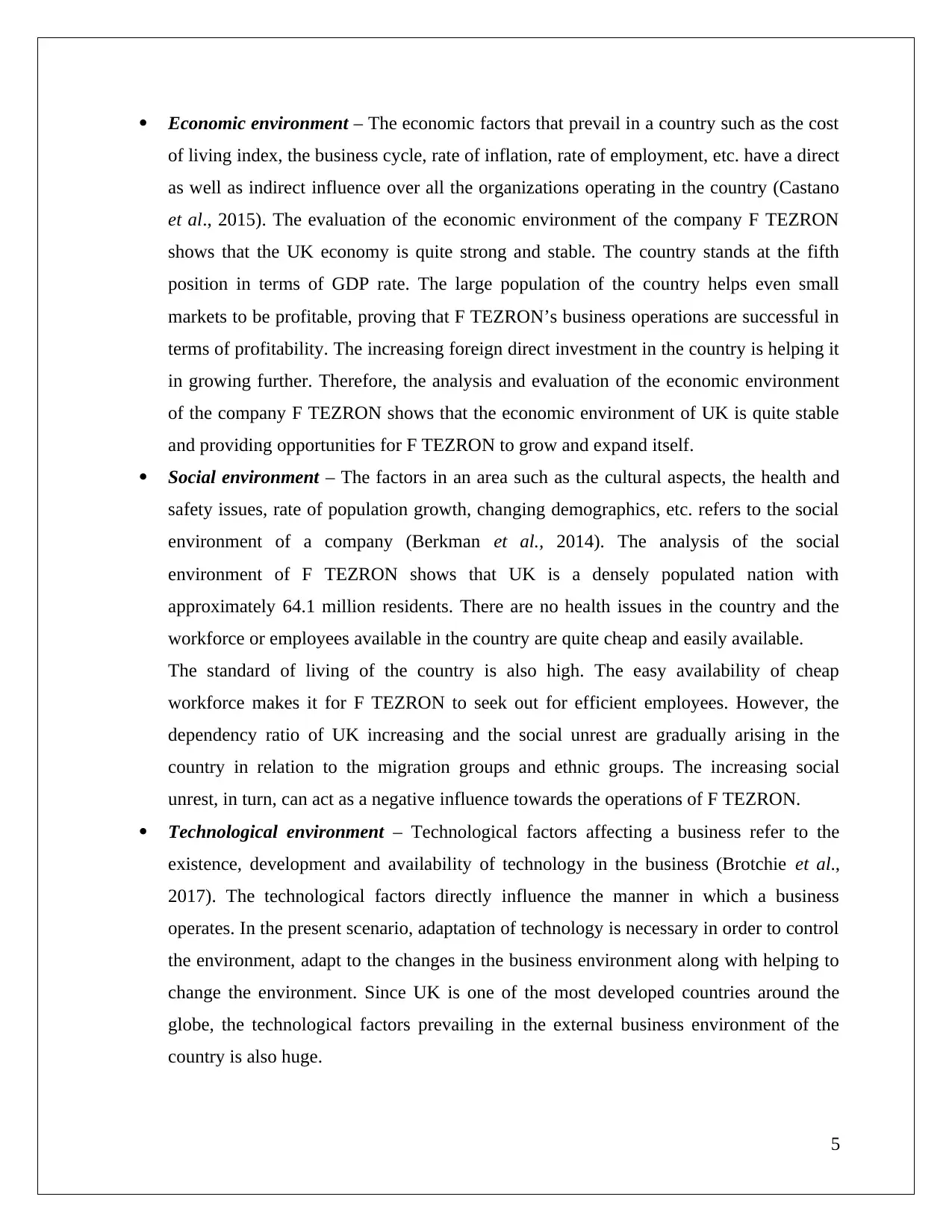
Economic environment – The economic factors that prevail in a country such as the cost
of living index, the business cycle, rate of inflation, rate of employment, etc. have a direct
as well as indirect influence over all the organizations operating in the country (Castano
et al., 2015). The evaluation of the economic environment of the company F TEZRON
shows that the UK economy is quite strong and stable. The country stands at the fifth
position in terms of GDP rate. The large population of the country helps even small
markets to be profitable, proving that F TEZRON’s business operations are successful in
terms of profitability. The increasing foreign direct investment in the country is helping it
in growing further. Therefore, the analysis and evaluation of the economic environment
of the company F TEZRON shows that the economic environment of UK is quite stable
and providing opportunities for F TEZRON to grow and expand itself.
Social environment – The factors in an area such as the cultural aspects, the health and
safety issues, rate of population growth, changing demographics, etc. refers to the social
environment of a company (Berkman et al., 2014). The analysis of the social
environment of F TEZRON shows that UK is a densely populated nation with
approximately 64.1 million residents. There are no health issues in the country and the
workforce or employees available in the country are quite cheap and easily available.
The standard of living of the country is also high. The easy availability of cheap
workforce makes it for F TEZRON to seek out for efficient employees. However, the
dependency ratio of UK increasing and the social unrest are gradually arising in the
country in relation to the migration groups and ethnic groups. The increasing social
unrest, in turn, can act as a negative influence towards the operations of F TEZRON.
Technological environment – Technological factors affecting a business refer to the
existence, development and availability of technology in the business (Brotchie et al.,
2017). The technological factors directly influence the manner in which a business
operates. In the present scenario, adaptation of technology is necessary in order to control
the environment, adapt to the changes in the business environment along with helping to
change the environment. Since UK is one of the most developed countries around the
globe, the technological factors prevailing in the external business environment of the
country is also huge.
5
of living index, the business cycle, rate of inflation, rate of employment, etc. have a direct
as well as indirect influence over all the organizations operating in the country (Castano
et al., 2015). The evaluation of the economic environment of the company F TEZRON
shows that the UK economy is quite strong and stable. The country stands at the fifth
position in terms of GDP rate. The large population of the country helps even small
markets to be profitable, proving that F TEZRON’s business operations are successful in
terms of profitability. The increasing foreign direct investment in the country is helping it
in growing further. Therefore, the analysis and evaluation of the economic environment
of the company F TEZRON shows that the economic environment of UK is quite stable
and providing opportunities for F TEZRON to grow and expand itself.
Social environment – The factors in an area such as the cultural aspects, the health and
safety issues, rate of population growth, changing demographics, etc. refers to the social
environment of a company (Berkman et al., 2014). The analysis of the social
environment of F TEZRON shows that UK is a densely populated nation with
approximately 64.1 million residents. There are no health issues in the country and the
workforce or employees available in the country are quite cheap and easily available.
The standard of living of the country is also high. The easy availability of cheap
workforce makes it for F TEZRON to seek out for efficient employees. However, the
dependency ratio of UK increasing and the social unrest are gradually arising in the
country in relation to the migration groups and ethnic groups. The increasing social
unrest, in turn, can act as a negative influence towards the operations of F TEZRON.
Technological environment – Technological factors affecting a business refer to the
existence, development and availability of technology in the business (Brotchie et al.,
2017). The technological factors directly influence the manner in which a business
operates. In the present scenario, adaptation of technology is necessary in order to control
the environment, adapt to the changes in the business environment along with helping to
change the environment. Since UK is one of the most developed countries around the
globe, the technological factors prevailing in the external business environment of the
country is also huge.
5
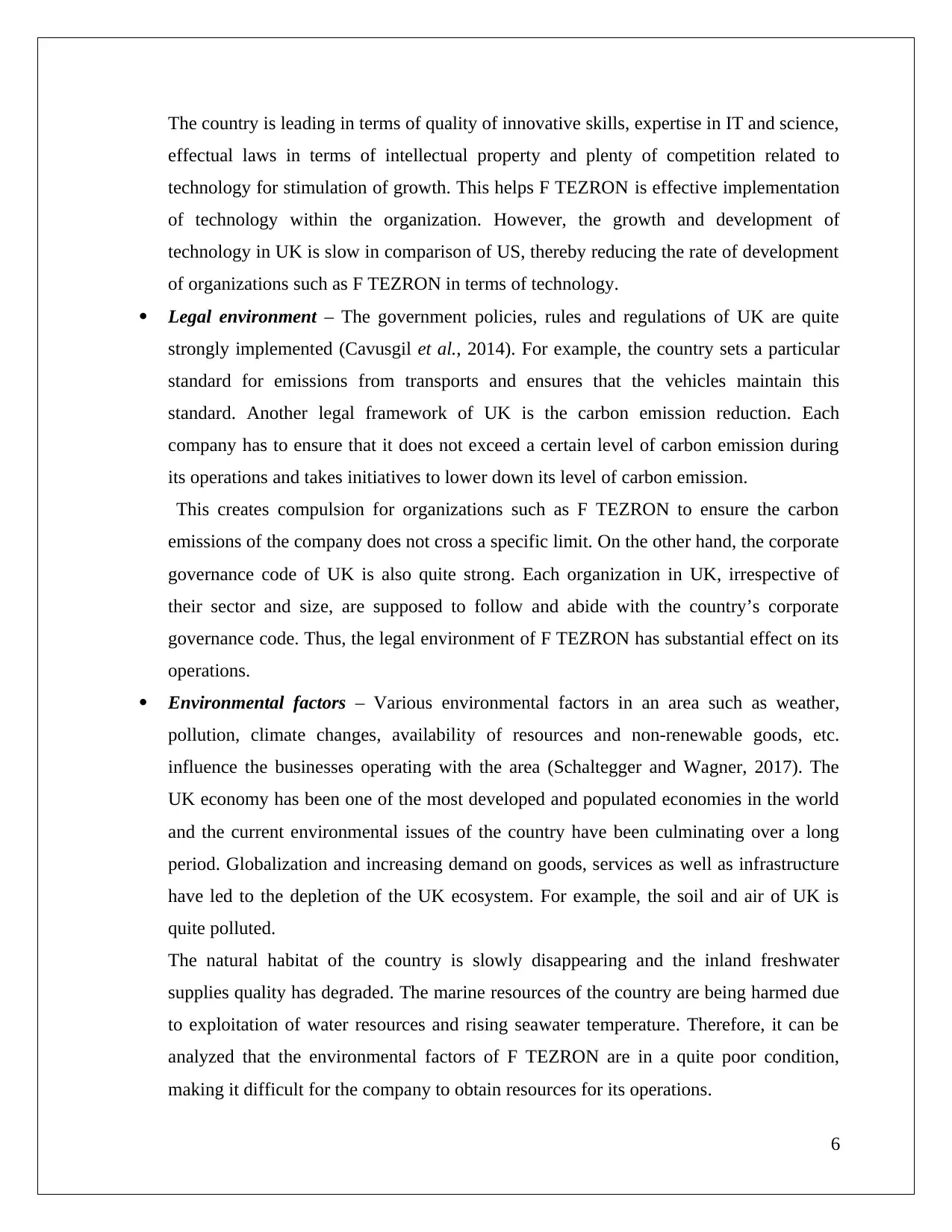
The country is leading in terms of quality of innovative skills, expertise in IT and science,
effectual laws in terms of intellectual property and plenty of competition related to
technology for stimulation of growth. This helps F TEZRON is effective implementation
of technology within the organization. However, the growth and development of
technology in UK is slow in comparison of US, thereby reducing the rate of development
of organizations such as F TEZRON in terms of technology.
Legal environment – The government policies, rules and regulations of UK are quite
strongly implemented (Cavusgil et al., 2014). For example, the country sets a particular
standard for emissions from transports and ensures that the vehicles maintain this
standard. Another legal framework of UK is the carbon emission reduction. Each
company has to ensure that it does not exceed a certain level of carbon emission during
its operations and takes initiatives to lower down its level of carbon emission.
This creates compulsion for organizations such as F TEZRON to ensure the carbon
emissions of the company does not cross a specific limit. On the other hand, the corporate
governance code of UK is also quite strong. Each organization in UK, irrespective of
their sector and size, are supposed to follow and abide with the country’s corporate
governance code. Thus, the legal environment of F TEZRON has substantial effect on its
operations.
Environmental factors – Various environmental factors in an area such as weather,
pollution, climate changes, availability of resources and non-renewable goods, etc.
influence the businesses operating with the area (Schaltegger and Wagner, 2017). The
UK economy has been one of the most developed and populated economies in the world
and the current environmental issues of the country have been culminating over a long
period. Globalization and increasing demand on goods, services as well as infrastructure
have led to the depletion of the UK ecosystem. For example, the soil and air of UK is
quite polluted.
The natural habitat of the country is slowly disappearing and the inland freshwater
supplies quality has degraded. The marine resources of the country are being harmed due
to exploitation of water resources and rising seawater temperature. Therefore, it can be
analyzed that the environmental factors of F TEZRON are in a quite poor condition,
making it difficult for the company to obtain resources for its operations.
6
effectual laws in terms of intellectual property and plenty of competition related to
technology for stimulation of growth. This helps F TEZRON is effective implementation
of technology within the organization. However, the growth and development of
technology in UK is slow in comparison of US, thereby reducing the rate of development
of organizations such as F TEZRON in terms of technology.
Legal environment – The government policies, rules and regulations of UK are quite
strongly implemented (Cavusgil et al., 2014). For example, the country sets a particular
standard for emissions from transports and ensures that the vehicles maintain this
standard. Another legal framework of UK is the carbon emission reduction. Each
company has to ensure that it does not exceed a certain level of carbon emission during
its operations and takes initiatives to lower down its level of carbon emission.
This creates compulsion for organizations such as F TEZRON to ensure the carbon
emissions of the company does not cross a specific limit. On the other hand, the corporate
governance code of UK is also quite strong. Each organization in UK, irrespective of
their sector and size, are supposed to follow and abide with the country’s corporate
governance code. Thus, the legal environment of F TEZRON has substantial effect on its
operations.
Environmental factors – Various environmental factors in an area such as weather,
pollution, climate changes, availability of resources and non-renewable goods, etc.
influence the businesses operating with the area (Schaltegger and Wagner, 2017). The
UK economy has been one of the most developed and populated economies in the world
and the current environmental issues of the country have been culminating over a long
period. Globalization and increasing demand on goods, services as well as infrastructure
have led to the depletion of the UK ecosystem. For example, the soil and air of UK is
quite polluted.
The natural habitat of the country is slowly disappearing and the inland freshwater
supplies quality has degraded. The marine resources of the country are being harmed due
to exploitation of water resources and rising seawater temperature. Therefore, it can be
analyzed that the environmental factors of F TEZRON are in a quite poor condition,
making it difficult for the company to obtain resources for its operations.
6
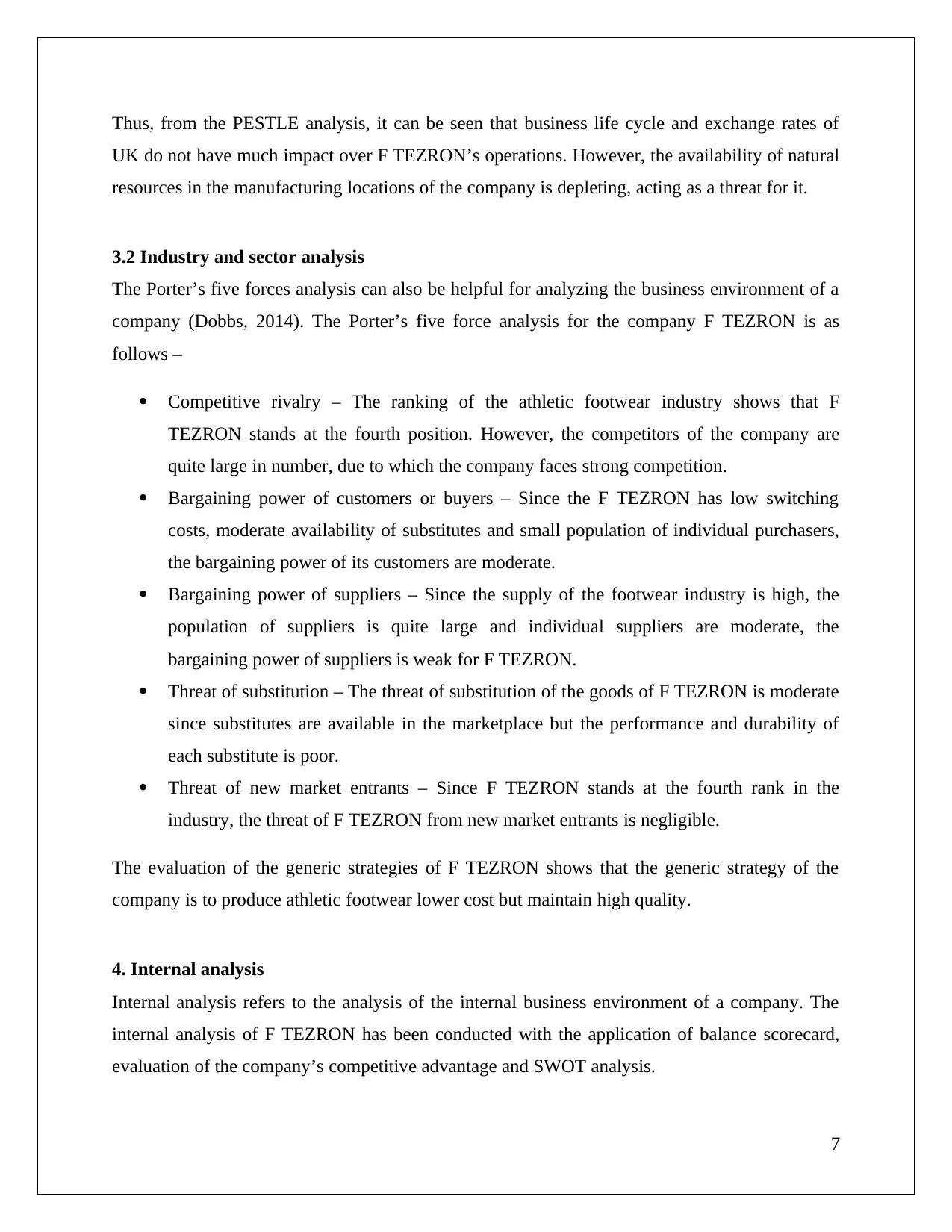
Thus, from the PESTLE analysis, it can be seen that business life cycle and exchange rates of
UK do not have much impact over F TEZRON’s operations. However, the availability of natural
resources in the manufacturing locations of the company is depleting, acting as a threat for it.
3.2 Industry and sector analysis
The Porter’s five forces analysis can also be helpful for analyzing the business environment of a
company (Dobbs, 2014). The Porter’s five force analysis for the company F TEZRON is as
follows –
Competitive rivalry – The ranking of the athletic footwear industry shows that F
TEZRON stands at the fourth position. However, the competitors of the company are
quite large in number, due to which the company faces strong competition.
Bargaining power of customers or buyers – Since the F TEZRON has low switching
costs, moderate availability of substitutes and small population of individual purchasers,
the bargaining power of its customers are moderate.
Bargaining power of suppliers – Since the supply of the footwear industry is high, the
population of suppliers is quite large and individual suppliers are moderate, the
bargaining power of suppliers is weak for F TEZRON.
Threat of substitution – The threat of substitution of the goods of F TEZRON is moderate
since substitutes are available in the marketplace but the performance and durability of
each substitute is poor.
Threat of new market entrants – Since F TEZRON stands at the fourth rank in the
industry, the threat of F TEZRON from new market entrants is negligible.
The evaluation of the generic strategies of F TEZRON shows that the generic strategy of the
company is to produce athletic footwear lower cost but maintain high quality.
4. Internal analysis
Internal analysis refers to the analysis of the internal business environment of a company. The
internal analysis of F TEZRON has been conducted with the application of balance scorecard,
evaluation of the company’s competitive advantage and SWOT analysis.
7
UK do not have much impact over F TEZRON’s operations. However, the availability of natural
resources in the manufacturing locations of the company is depleting, acting as a threat for it.
3.2 Industry and sector analysis
The Porter’s five forces analysis can also be helpful for analyzing the business environment of a
company (Dobbs, 2014). The Porter’s five force analysis for the company F TEZRON is as
follows –
Competitive rivalry – The ranking of the athletic footwear industry shows that F
TEZRON stands at the fourth position. However, the competitors of the company are
quite large in number, due to which the company faces strong competition.
Bargaining power of customers or buyers – Since the F TEZRON has low switching
costs, moderate availability of substitutes and small population of individual purchasers,
the bargaining power of its customers are moderate.
Bargaining power of suppliers – Since the supply of the footwear industry is high, the
population of suppliers is quite large and individual suppliers are moderate, the
bargaining power of suppliers is weak for F TEZRON.
Threat of substitution – The threat of substitution of the goods of F TEZRON is moderate
since substitutes are available in the marketplace but the performance and durability of
each substitute is poor.
Threat of new market entrants – Since F TEZRON stands at the fourth rank in the
industry, the threat of F TEZRON from new market entrants is negligible.
The evaluation of the generic strategies of F TEZRON shows that the generic strategy of the
company is to produce athletic footwear lower cost but maintain high quality.
4. Internal analysis
Internal analysis refers to the analysis of the internal business environment of a company. The
internal analysis of F TEZRON has been conducted with the application of balance scorecard,
evaluation of the company’s competitive advantage and SWOT analysis.
7
Paraphrase This Document
Need a fresh take? Get an instant paraphrase of this document with our AI Paraphraser
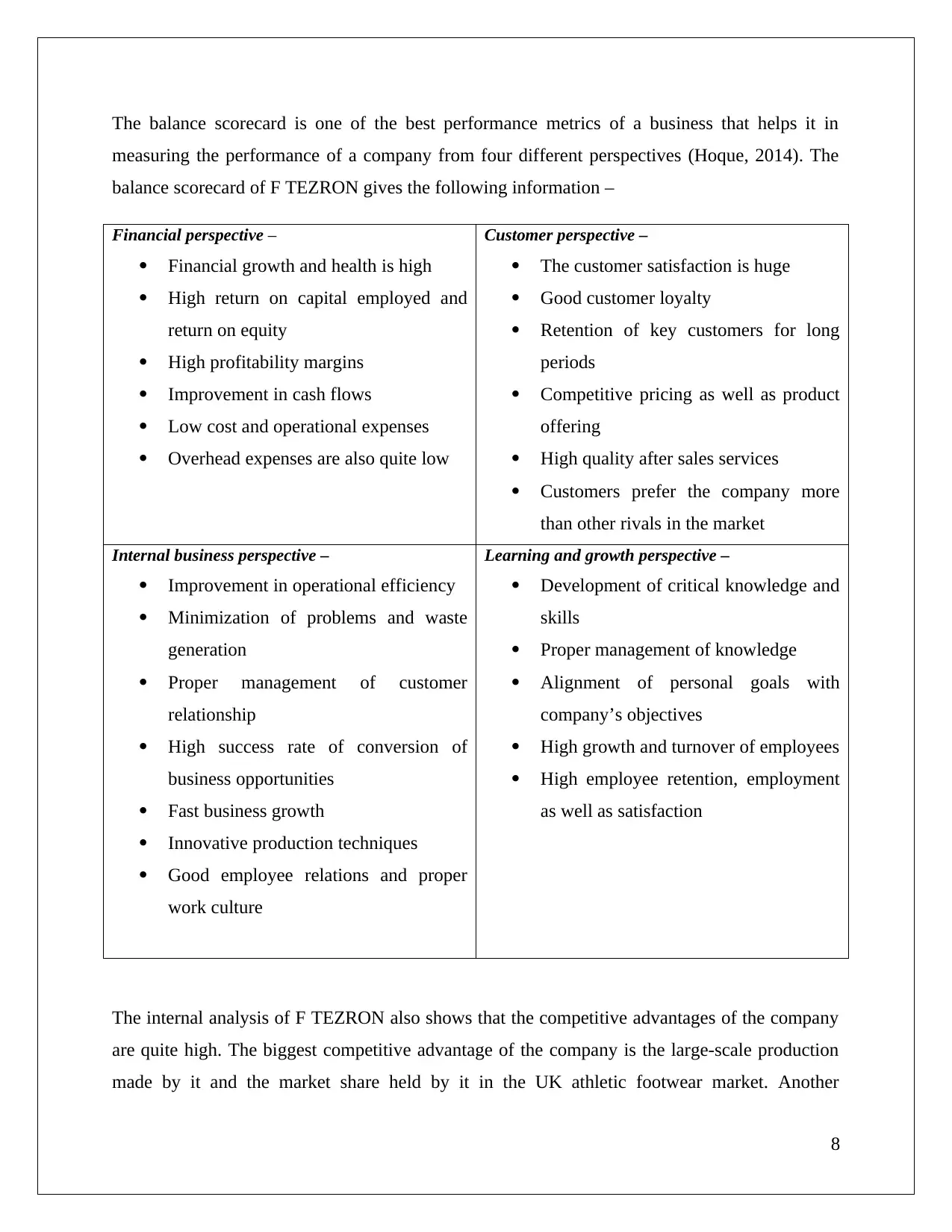
The balance scorecard is one of the best performance metrics of a business that helps it in
measuring the performance of a company from four different perspectives (Hoque, 2014). The
balance scorecard of F TEZRON gives the following information –
Financial perspective –
Financial growth and health is high
High return on capital employed and
return on equity
High profitability margins
Improvement in cash flows
Low cost and operational expenses
Overhead expenses are also quite low
Customer perspective –
The customer satisfaction is huge
Good customer loyalty
Retention of key customers for long
periods
Competitive pricing as well as product
offering
High quality after sales services
Customers prefer the company more
than other rivals in the market
Internal business perspective –
Improvement in operational efficiency
Minimization of problems and waste
generation
Proper management of customer
relationship
High success rate of conversion of
business opportunities
Fast business growth
Innovative production techniques
Good employee relations and proper
work culture
Learning and growth perspective –
Development of critical knowledge and
skills
Proper management of knowledge
Alignment of personal goals with
company’s objectives
High growth and turnover of employees
High employee retention, employment
as well as satisfaction
The internal analysis of F TEZRON also shows that the competitive advantages of the company
are quite high. The biggest competitive advantage of the company is the large-scale production
made by it and the market share held by it in the UK athletic footwear market. Another
8
measuring the performance of a company from four different perspectives (Hoque, 2014). The
balance scorecard of F TEZRON gives the following information –
Financial perspective –
Financial growth and health is high
High return on capital employed and
return on equity
High profitability margins
Improvement in cash flows
Low cost and operational expenses
Overhead expenses are also quite low
Customer perspective –
The customer satisfaction is huge
Good customer loyalty
Retention of key customers for long
periods
Competitive pricing as well as product
offering
High quality after sales services
Customers prefer the company more
than other rivals in the market
Internal business perspective –
Improvement in operational efficiency
Minimization of problems and waste
generation
Proper management of customer
relationship
High success rate of conversion of
business opportunities
Fast business growth
Innovative production techniques
Good employee relations and proper
work culture
Learning and growth perspective –
Development of critical knowledge and
skills
Proper management of knowledge
Alignment of personal goals with
company’s objectives
High growth and turnover of employees
High employee retention, employment
as well as satisfaction
The internal analysis of F TEZRON also shows that the competitive advantages of the company
are quite high. The biggest competitive advantage of the company is the large-scale production
made by it and the market share held by it in the UK athletic footwear market. Another
8
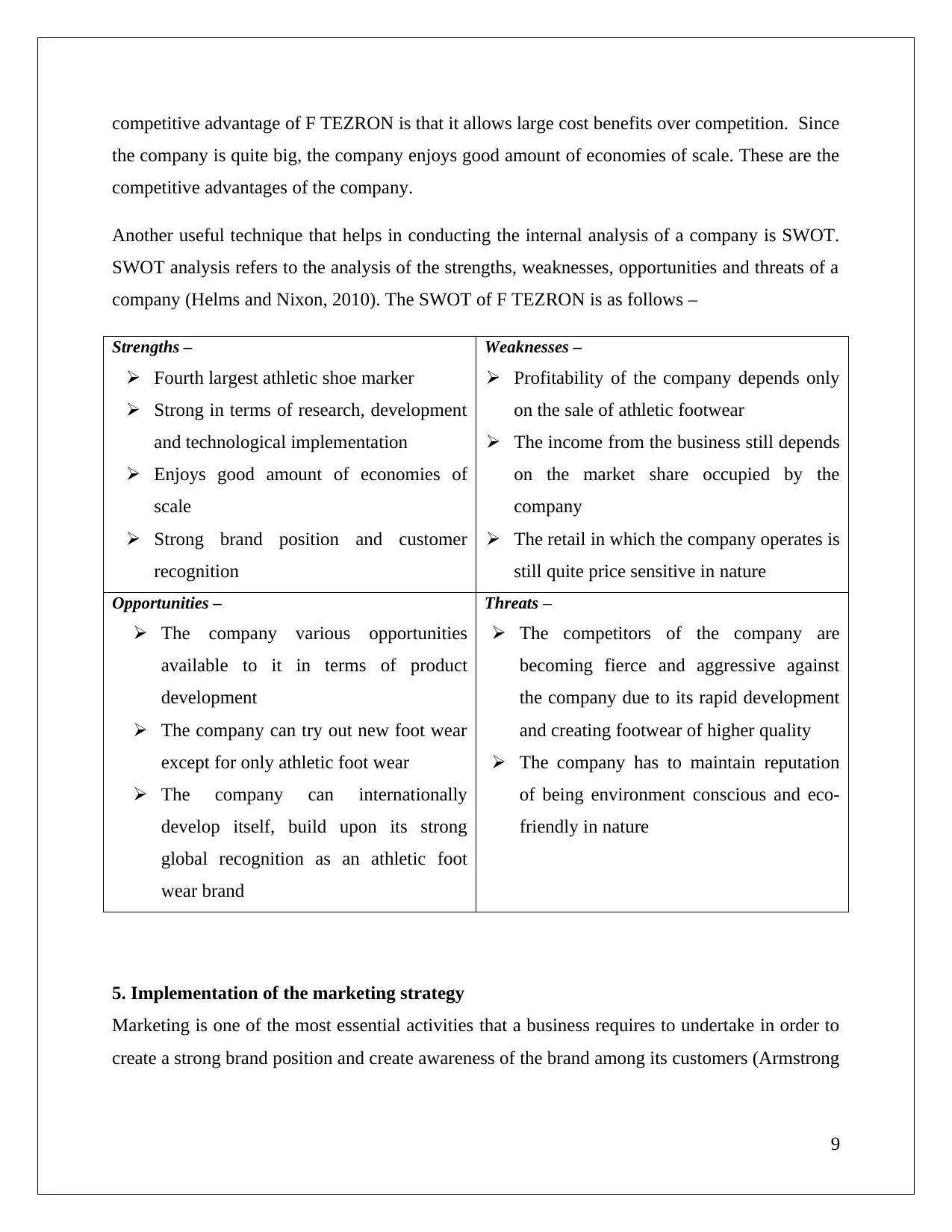
competitive advantage of F TEZRON is that it allows large cost benefits over competition. Since
the company is quite big, the company enjoys good amount of economies of scale. These are the
competitive advantages of the company.
Another useful technique that helps in conducting the internal analysis of a company is SWOT.
SWOT analysis refers to the analysis of the strengths, weaknesses, opportunities and threats of a
company (Helms and Nixon, 2010). The SWOT of F TEZRON is as follows –
Strengths –
Fourth largest athletic shoe marker
Strong in terms of research, development
and technological implementation
Enjoys good amount of economies of
scale
Strong brand position and customer
recognition
Weaknesses –
Profitability of the company depends only
on the sale of athletic footwear
The income from the business still depends
on the market share occupied by the
company
The retail in which the company operates is
still quite price sensitive in nature
Opportunities –
The company various opportunities
available to it in terms of product
development
The company can try out new foot wear
except for only athletic foot wear
The company can internationally
develop itself, build upon its strong
global recognition as an athletic foot
wear brand
Threats –
The competitors of the company are
becoming fierce and aggressive against
the company due to its rapid development
and creating footwear of higher quality
The company has to maintain reputation
of being environment conscious and eco-
friendly in nature
5. Implementation of the marketing strategy
Marketing is one of the most essential activities that a business requires to undertake in order to
create a strong brand position and create awareness of the brand among its customers (Armstrong
9
the company is quite big, the company enjoys good amount of economies of scale. These are the
competitive advantages of the company.
Another useful technique that helps in conducting the internal analysis of a company is SWOT.
SWOT analysis refers to the analysis of the strengths, weaknesses, opportunities and threats of a
company (Helms and Nixon, 2010). The SWOT of F TEZRON is as follows –
Strengths –
Fourth largest athletic shoe marker
Strong in terms of research, development
and technological implementation
Enjoys good amount of economies of
scale
Strong brand position and customer
recognition
Weaknesses –
Profitability of the company depends only
on the sale of athletic footwear
The income from the business still depends
on the market share occupied by the
company
The retail in which the company operates is
still quite price sensitive in nature
Opportunities –
The company various opportunities
available to it in terms of product
development
The company can try out new foot wear
except for only athletic foot wear
The company can internationally
develop itself, build upon its strong
global recognition as an athletic foot
wear brand
Threats –
The competitors of the company are
becoming fierce and aggressive against
the company due to its rapid development
and creating footwear of higher quality
The company has to maintain reputation
of being environment conscious and eco-
friendly in nature
5. Implementation of the marketing strategy
Marketing is one of the most essential activities that a business requires to undertake in order to
create a strong brand position and create awareness of the brand among its customers (Armstrong
9
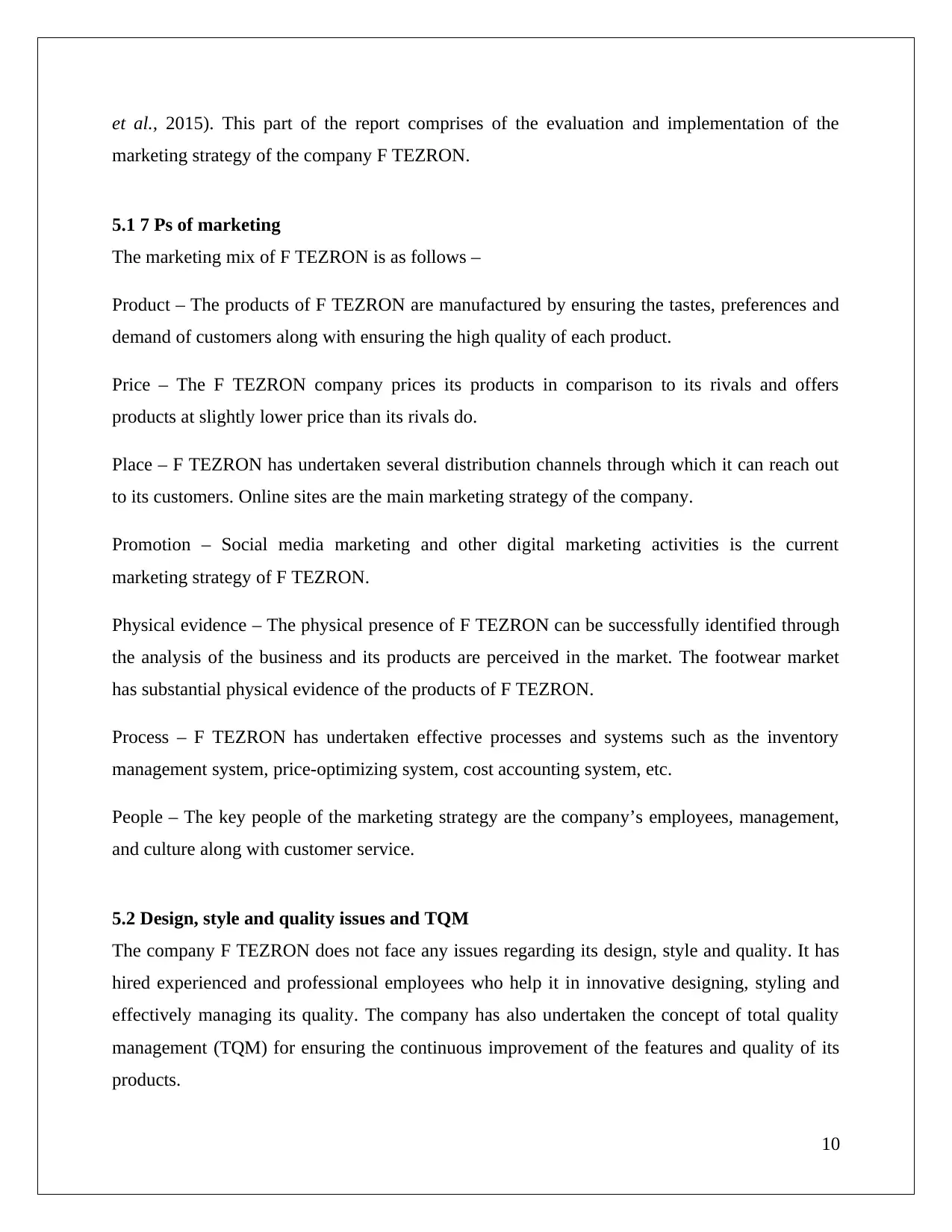
et al., 2015). This part of the report comprises of the evaluation and implementation of the
marketing strategy of the company F TEZRON.
5.1 7 Ps of marketing
The marketing mix of F TEZRON is as follows –
Product – The products of F TEZRON are manufactured by ensuring the tastes, preferences and
demand of customers along with ensuring the high quality of each product.
Price – The F TEZRON company prices its products in comparison to its rivals and offers
products at slightly lower price than its rivals do.
Place – F TEZRON has undertaken several distribution channels through which it can reach out
to its customers. Online sites are the main marketing strategy of the company.
Promotion – Social media marketing and other digital marketing activities is the current
marketing strategy of F TEZRON.
Physical evidence – The physical presence of F TEZRON can be successfully identified through
the analysis of the business and its products are perceived in the market. The footwear market
has substantial physical evidence of the products of F TEZRON.
Process – F TEZRON has undertaken effective processes and systems such as the inventory
management system, price-optimizing system, cost accounting system, etc.
People – The key people of the marketing strategy are the company’s employees, management,
and culture along with customer service.
5.2 Design, style and quality issues and TQM
The company F TEZRON does not face any issues regarding its design, style and quality. It has
hired experienced and professional employees who help it in innovative designing, styling and
effectively managing its quality. The company has also undertaken the concept of total quality
management (TQM) for ensuring the continuous improvement of the features and quality of its
products.
10
marketing strategy of the company F TEZRON.
5.1 7 Ps of marketing
The marketing mix of F TEZRON is as follows –
Product – The products of F TEZRON are manufactured by ensuring the tastes, preferences and
demand of customers along with ensuring the high quality of each product.
Price – The F TEZRON company prices its products in comparison to its rivals and offers
products at slightly lower price than its rivals do.
Place – F TEZRON has undertaken several distribution channels through which it can reach out
to its customers. Online sites are the main marketing strategy of the company.
Promotion – Social media marketing and other digital marketing activities is the current
marketing strategy of F TEZRON.
Physical evidence – The physical presence of F TEZRON can be successfully identified through
the analysis of the business and its products are perceived in the market. The footwear market
has substantial physical evidence of the products of F TEZRON.
Process – F TEZRON has undertaken effective processes and systems such as the inventory
management system, price-optimizing system, cost accounting system, etc.
People – The key people of the marketing strategy are the company’s employees, management,
and culture along with customer service.
5.2 Design, style and quality issues and TQM
The company F TEZRON does not face any issues regarding its design, style and quality. It has
hired experienced and professional employees who help it in innovative designing, styling and
effectively managing its quality. The company has also undertaken the concept of total quality
management (TQM) for ensuring the continuous improvement of the features and quality of its
products.
10
Secure Best Marks with AI Grader
Need help grading? Try our AI Grader for instant feedback on your assignments.
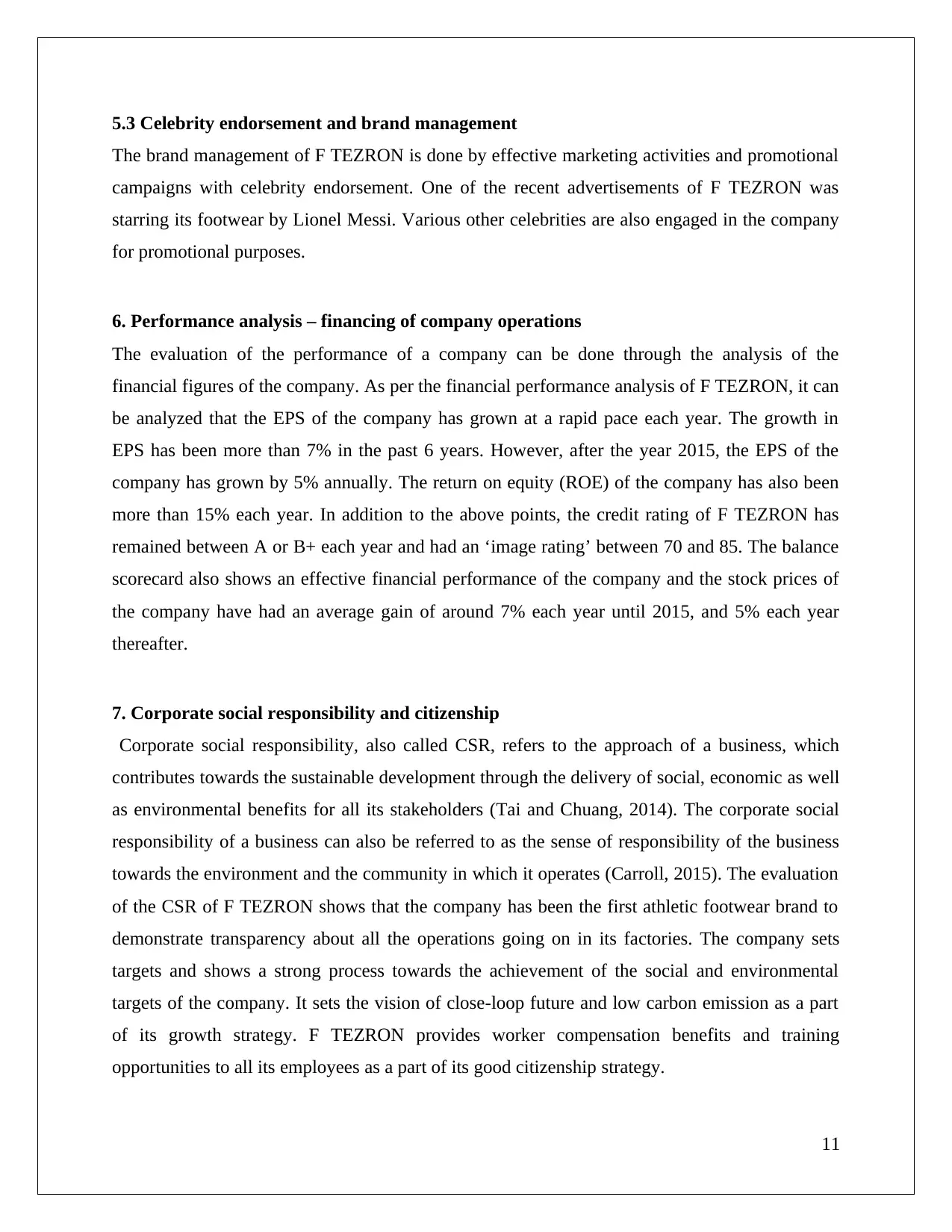
5.3 Celebrity endorsement and brand management
The brand management of F TEZRON is done by effective marketing activities and promotional
campaigns with celebrity endorsement. One of the recent advertisements of F TEZRON was
starring its footwear by Lionel Messi. Various other celebrities are also engaged in the company
for promotional purposes.
6. Performance analysis – financing of company operations
The evaluation of the performance of a company can be done through the analysis of the
financial figures of the company. As per the financial performance analysis of F TEZRON, it can
be analyzed that the EPS of the company has grown at a rapid pace each year. The growth in
EPS has been more than 7% in the past 6 years. However, after the year 2015, the EPS of the
company has grown by 5% annually. The return on equity (ROE) of the company has also been
more than 15% each year. In addition to the above points, the credit rating of F TEZRON has
remained between A or B+ each year and had an ‘image rating’ between 70 and 85. The balance
scorecard also shows an effective financial performance of the company and the stock prices of
the company have had an average gain of around 7% each year until 2015, and 5% each year
thereafter.
7. Corporate social responsibility and citizenship
Corporate social responsibility, also called CSR, refers to the approach of a business, which
contributes towards the sustainable development through the delivery of social, economic as well
as environmental benefits for all its stakeholders (Tai and Chuang, 2014). The corporate social
responsibility of a business can also be referred to as the sense of responsibility of the business
towards the environment and the community in which it operates (Carroll, 2015). The evaluation
of the CSR of F TEZRON shows that the company has been the first athletic footwear brand to
demonstrate transparency about all the operations going on in its factories. The company sets
targets and shows a strong process towards the achievement of the social and environmental
targets of the company. It sets the vision of close-loop future and low carbon emission as a part
of its growth strategy. F TEZRON provides worker compensation benefits and training
opportunities to all its employees as a part of its good citizenship strategy.
11
The brand management of F TEZRON is done by effective marketing activities and promotional
campaigns with celebrity endorsement. One of the recent advertisements of F TEZRON was
starring its footwear by Lionel Messi. Various other celebrities are also engaged in the company
for promotional purposes.
6. Performance analysis – financing of company operations
The evaluation of the performance of a company can be done through the analysis of the
financial figures of the company. As per the financial performance analysis of F TEZRON, it can
be analyzed that the EPS of the company has grown at a rapid pace each year. The growth in
EPS has been more than 7% in the past 6 years. However, after the year 2015, the EPS of the
company has grown by 5% annually. The return on equity (ROE) of the company has also been
more than 15% each year. In addition to the above points, the credit rating of F TEZRON has
remained between A or B+ each year and had an ‘image rating’ between 70 and 85. The balance
scorecard also shows an effective financial performance of the company and the stock prices of
the company have had an average gain of around 7% each year until 2015, and 5% each year
thereafter.
7. Corporate social responsibility and citizenship
Corporate social responsibility, also called CSR, refers to the approach of a business, which
contributes towards the sustainable development through the delivery of social, economic as well
as environmental benefits for all its stakeholders (Tai and Chuang, 2014). The corporate social
responsibility of a business can also be referred to as the sense of responsibility of the business
towards the environment and the community in which it operates (Carroll, 2015). The evaluation
of the CSR of F TEZRON shows that the company has been the first athletic footwear brand to
demonstrate transparency about all the operations going on in its factories. The company sets
targets and shows a strong process towards the achievement of the social and environmental
targets of the company. It sets the vision of close-loop future and low carbon emission as a part
of its growth strategy. F TEZRON provides worker compensation benefits and training
opportunities to all its employees as a part of its good citizenship strategy.
11
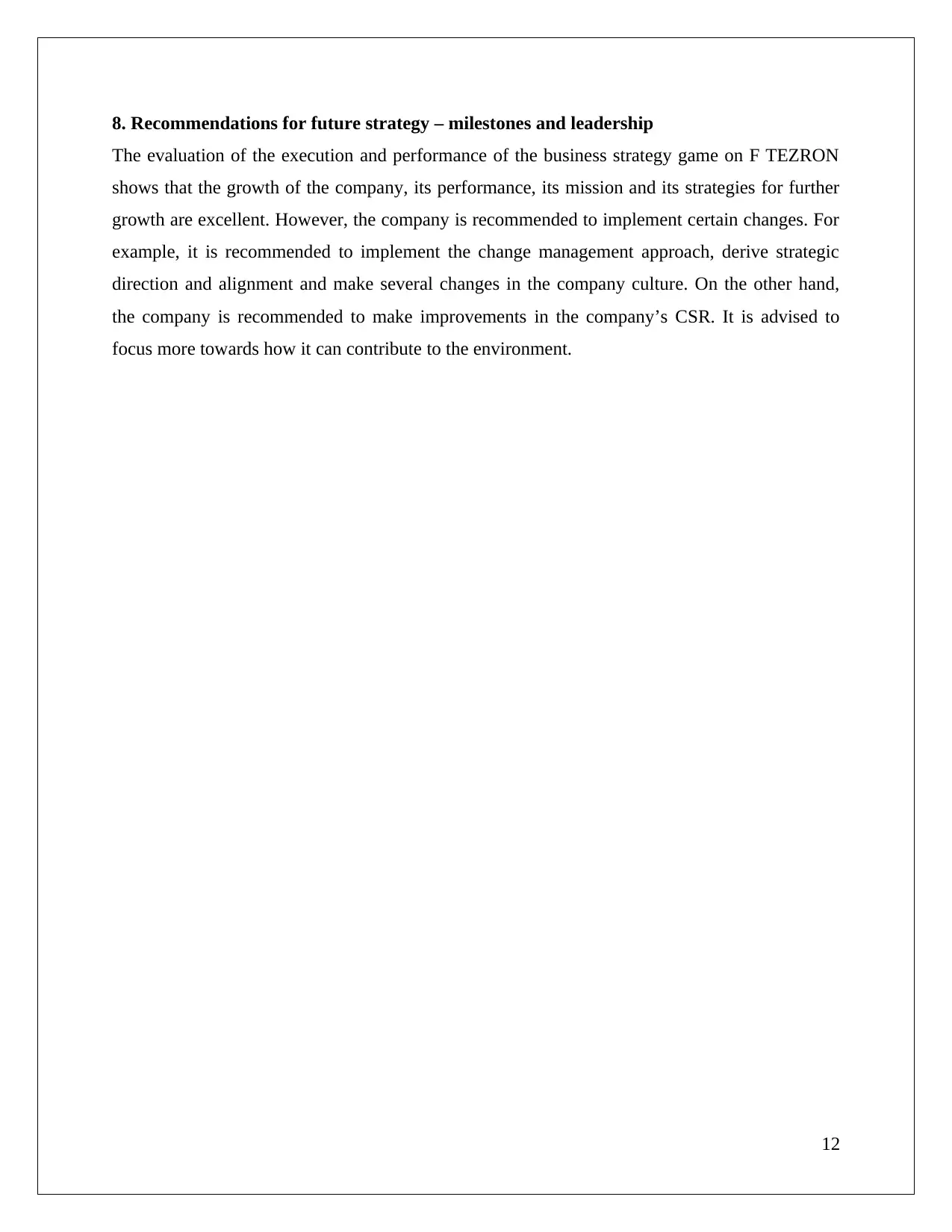
8. Recommendations for future strategy – milestones and leadership
The evaluation of the execution and performance of the business strategy game on F TEZRON
shows that the growth of the company, its performance, its mission and its strategies for further
growth are excellent. However, the company is recommended to implement certain changes. For
example, it is recommended to implement the change management approach, derive strategic
direction and alignment and make several changes in the company culture. On the other hand,
the company is recommended to make improvements in the company’s CSR. It is advised to
focus more towards how it can contribute to the environment.
12
The evaluation of the execution and performance of the business strategy game on F TEZRON
shows that the growth of the company, its performance, its mission and its strategies for further
growth are excellent. However, the company is recommended to implement certain changes. For
example, it is recommended to implement the change management approach, derive strategic
direction and alignment and make several changes in the company culture. On the other hand,
the company is recommended to make improvements in the company’s CSR. It is advised to
focus more towards how it can contribute to the environment.
12
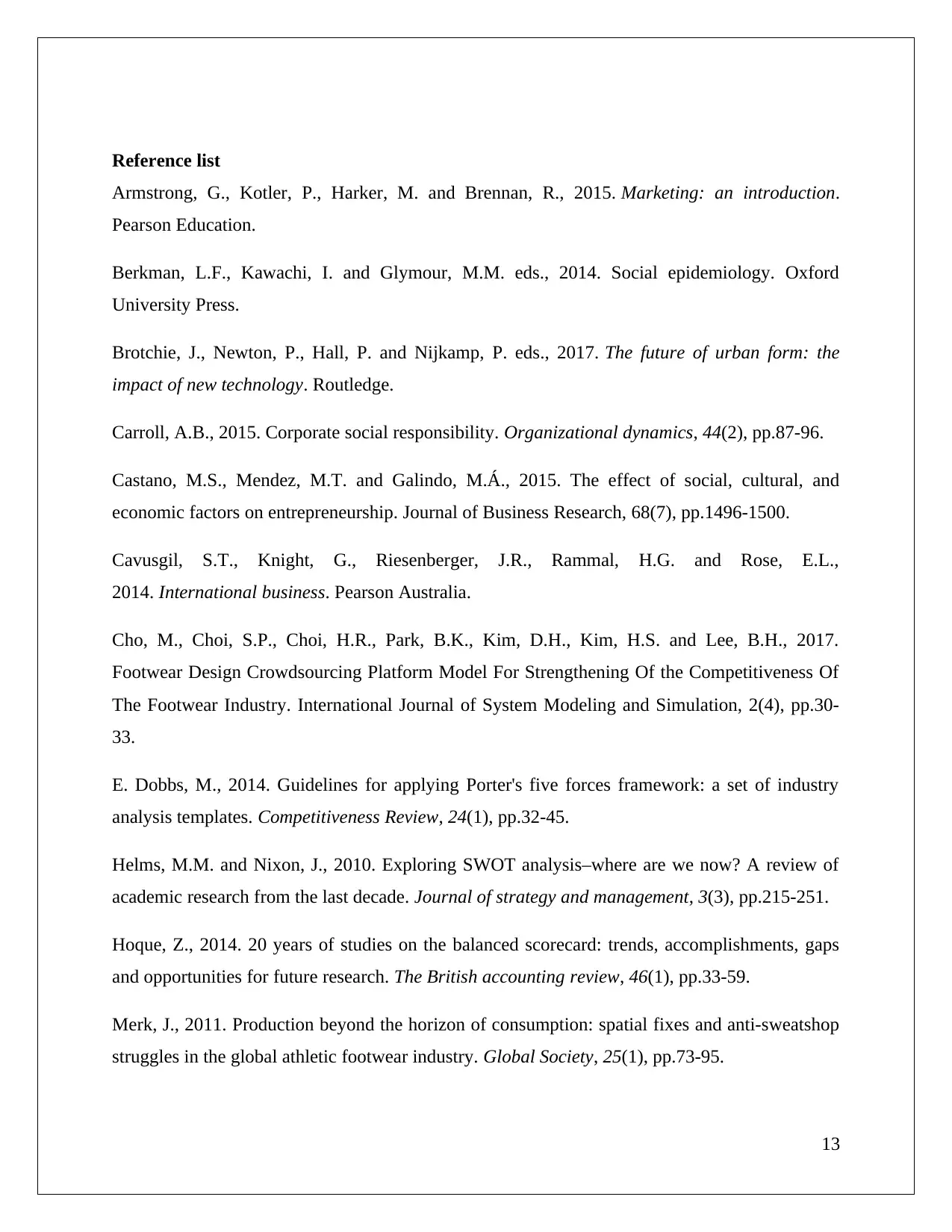
Reference list
Armstrong, G., Kotler, P., Harker, M. and Brennan, R., 2015. Marketing: an introduction.
Pearson Education.
Berkman, L.F., Kawachi, I. and Glymour, M.M. eds., 2014. Social epidemiology. Oxford
University Press.
Brotchie, J., Newton, P., Hall, P. and Nijkamp, P. eds., 2017. The future of urban form: the
impact of new technology. Routledge.
Carroll, A.B., 2015. Corporate social responsibility. Organizational dynamics, 44(2), pp.87-96.
Castano, M.S., Mendez, M.T. and Galindo, M.Á., 2015. The effect of social, cultural, and
economic factors on entrepreneurship. Journal of Business Research, 68(7), pp.1496-1500.
Cavusgil, S.T., Knight, G., Riesenberger, J.R., Rammal, H.G. and Rose, E.L.,
2014. International business. Pearson Australia.
Cho, M., Choi, S.P., Choi, H.R., Park, B.K., Kim, D.H., Kim, H.S. and Lee, B.H., 2017.
Footwear Design Crowdsourcing Platform Model For Strengthening Of the Competitiveness Of
The Footwear Industry. International Journal of System Modeling and Simulation, 2(4), pp.30-
33.
E. Dobbs, M., 2014. Guidelines for applying Porter's five forces framework: a set of industry
analysis templates. Competitiveness Review, 24(1), pp.32-45.
Helms, M.M. and Nixon, J., 2010. Exploring SWOT analysis–where are we now? A review of
academic research from the last decade. Journal of strategy and management, 3(3), pp.215-251.
Hoque, Z., 2014. 20 years of studies on the balanced scorecard: trends, accomplishments, gaps
and opportunities for future research. The British accounting review, 46(1), pp.33-59.
Merk, J., 2011. Production beyond the horizon of consumption: spatial fixes and anti-sweatshop
struggles in the global athletic footwear industry. Global Society, 25(1), pp.73-95.
13
Armstrong, G., Kotler, P., Harker, M. and Brennan, R., 2015. Marketing: an introduction.
Pearson Education.
Berkman, L.F., Kawachi, I. and Glymour, M.M. eds., 2014. Social epidemiology. Oxford
University Press.
Brotchie, J., Newton, P., Hall, P. and Nijkamp, P. eds., 2017. The future of urban form: the
impact of new technology. Routledge.
Carroll, A.B., 2015. Corporate social responsibility. Organizational dynamics, 44(2), pp.87-96.
Castano, M.S., Mendez, M.T. and Galindo, M.Á., 2015. The effect of social, cultural, and
economic factors on entrepreneurship. Journal of Business Research, 68(7), pp.1496-1500.
Cavusgil, S.T., Knight, G., Riesenberger, J.R., Rammal, H.G. and Rose, E.L.,
2014. International business. Pearson Australia.
Cho, M., Choi, S.P., Choi, H.R., Park, B.K., Kim, D.H., Kim, H.S. and Lee, B.H., 2017.
Footwear Design Crowdsourcing Platform Model For Strengthening Of the Competitiveness Of
The Footwear Industry. International Journal of System Modeling and Simulation, 2(4), pp.30-
33.
E. Dobbs, M., 2014. Guidelines for applying Porter's five forces framework: a set of industry
analysis templates. Competitiveness Review, 24(1), pp.32-45.
Helms, M.M. and Nixon, J., 2010. Exploring SWOT analysis–where are we now? A review of
academic research from the last decade. Journal of strategy and management, 3(3), pp.215-251.
Hoque, Z., 2014. 20 years of studies on the balanced scorecard: trends, accomplishments, gaps
and opportunities for future research. The British accounting review, 46(1), pp.33-59.
Merk, J., 2011. Production beyond the horizon of consumption: spatial fixes and anti-sweatshop
struggles in the global athletic footwear industry. Global Society, 25(1), pp.73-95.
13
Paraphrase This Document
Need a fresh take? Get an instant paraphrase of this document with our AI Paraphraser
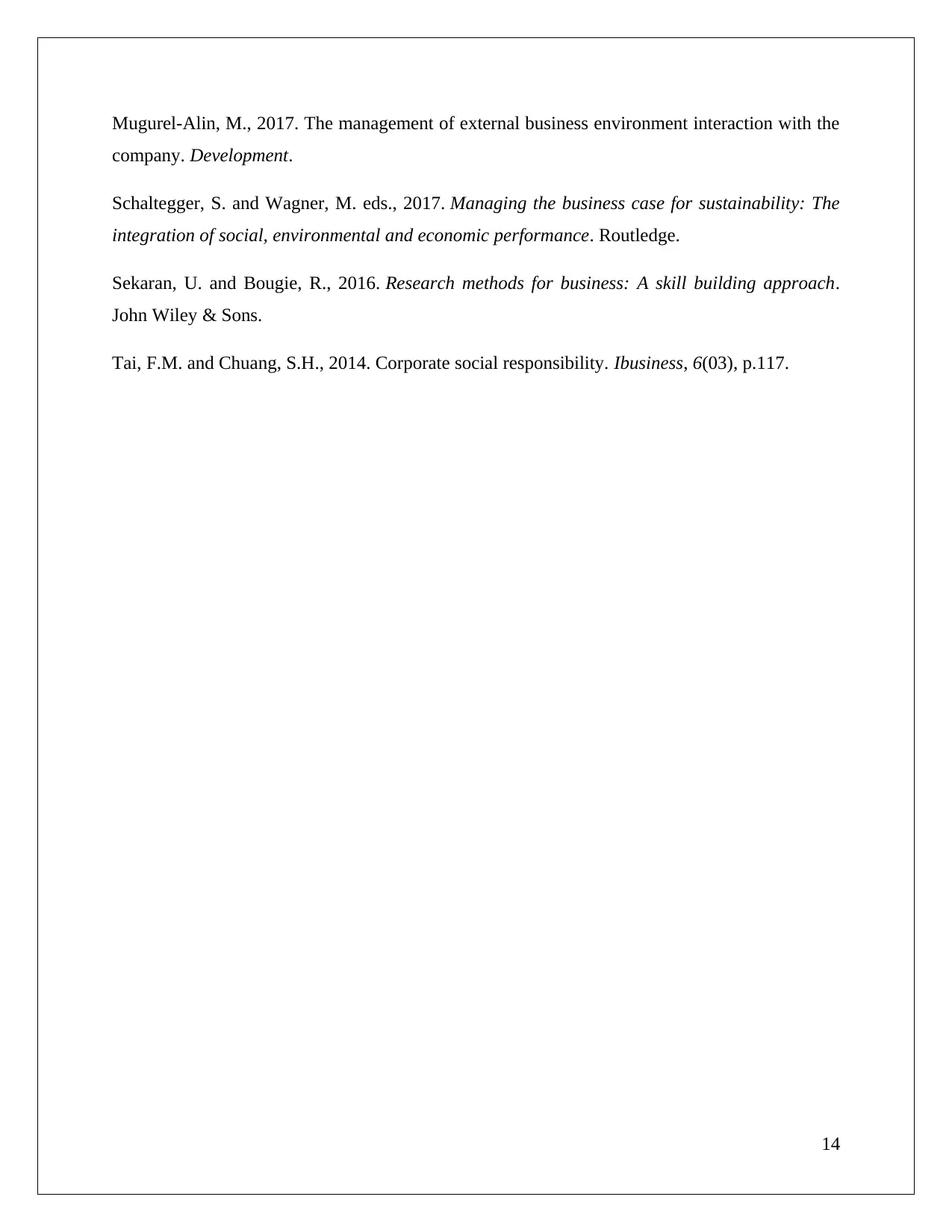
Mugurel-Alin, M., 2017. The management of external business environment interaction with the
company. Development.
Schaltegger, S. and Wagner, M. eds., 2017. Managing the business case for sustainability: The
integration of social, environmental and economic performance. Routledge.
Sekaran, U. and Bougie, R., 2016. Research methods for business: A skill building approach.
John Wiley & Sons.
Tai, F.M. and Chuang, S.H., 2014. Corporate social responsibility. Ibusiness, 6(03), p.117.
14
company. Development.
Schaltegger, S. and Wagner, M. eds., 2017. Managing the business case for sustainability: The
integration of social, environmental and economic performance. Routledge.
Sekaran, U. and Bougie, R., 2016. Research methods for business: A skill building approach.
John Wiley & Sons.
Tai, F.M. and Chuang, S.H., 2014. Corporate social responsibility. Ibusiness, 6(03), p.117.
14
1 out of 14
Related Documents
Your All-in-One AI-Powered Toolkit for Academic Success.
+13062052269
info@desklib.com
Available 24*7 on WhatsApp / Email
![[object Object]](/_next/static/media/star-bottom.7253800d.svg)
Unlock your academic potential
© 2024 | Zucol Services PVT LTD | All rights reserved.





